Abstract
In this study, we investigated the use of the pre-sowing electrophysical stimulation of seeds, particularly focusing on optimizing technological regimes for enhancing seed quality. The aim of this study was to improve sunflower seed germination utilizing laser optical radiation. The methods explored involved the pre-sowing stimulation of oilseeds and analyzing the key mechanisms affecting germination. Through our experimental research, we sought to identify the most effective laser irradiation parameters, ensuring the maximum seed quality improvement with minimal energy use. Using seeds of the first reproduction, we employed artificial aging to simulate a reduced seed quality and determined optimal irradiation regimes. Standard methods were followed to assess seed quality before and after irradiation, with 6–7 days of further exposure. Seed germination was carried out under controlled light and temperature conditions using the “on paper” method with paper napkins. A full factorial experiment was performed and key parameters for laser irradiation were determined, confirming that the pre-sowing laser pulse treatment significantly improved seed quality. In this research, we developed a biotechnical system for processing seeds and propose a method to adjust irradiation parameters based on the initial seed quality. The system effectively enhanced germination and crop yield, offering a reliable solution for improving sunflower seed productivity through laser treatment.
1. Introduction
An analysis of trends in the development of agro-industrial production in Ukraine and developed capitalist countries shows that the growth of energy and material costs for the production of plant products surpasses the growth of productivity. Therefore, scientific research related to the development of the latest energy-resource-saving technologies that facilitate increases in the productivity of plant biosystems shows great promise.
The sowing quality of seeds largely determines the yield of vegetable crops. Moreover, the need to have an insurance fund of seeds for a number of crops, a decrease in the sowing quality of seeds during storage, especially under non-optimal conditions, and the lack of a single effective system for monitoring the quality of the supplied seed material lead to decreases in the quality indicators of seeds. This in turn often leads to the insufficiently rational use of areas around vegetable crops, an increase in the costs involved in their cultivation, and a shortfall in yield. Therefore, various methods for the pre-sowing stimulation of seeds have been employed, which, in addition, have a stimulating effect not only on germination processes but also on the growth and development of plants and thereby facilitate an increase in the yield of vegetable crops. One of the most effective methods for the pre-sowing stimulation of seeds is laser irradiation, in particular, pulsed irradiation. However, existing recommendations are largely based on empirical data that are random in nature and do not have sufficient theoretical justification, which significantly hinders their widespread implementation. In addition, the relatively high cost of universal laser equipment and the seasonality of its use for pre-sowing seed irradiation prevents its use in agricultural production, especially for small farms (farm, individual, and household plots), for which it is most needed due to the inability to exercise sufficient control over purchased seeds. Therefore, the search for and justification of the most effective technological modes of irradiation of vegetable crop seeds using information on the initial quality indicators of seeds and the development of technological means for irradiating seeds of various crops, varieties, and initial quality for the conditions of various farms is one of the promising areas for increasing the efficiency of the pulsed laser stimulation of seeds and increasing the efficiency of plant growth in general. This task is effectively solved by stimulating the phytochrome system of seeds when they are subjected to pulsed laser irradiation using data on their initial sowing quality and data on the type and variety of stimulated seeds using special attachments to universal units and specialized irradiation units with microprocessor control systems for irradiation parameters. Therefore, a study of the dependence of the sowing quality of seeds on the parameters of irradiation modes, their influences on plant development, and the development of microprocessor control means and technical means for implementing optimal modes is one of the most promising ways to increase the efficiency of the pre-sowing pulsed laser irradiation of seeds.
However, the relatively high cost of the equipment required and the lack of recommendations on the parameters of seed processing prevent its use in agricultural production, especially for small farms. Therefore, in the search for and justification of the most effective technological regimes for the pre-sowing processing of sunflower seeds using information about the initial qualitative indicators of said seeds, the development of technical means for its implementation is relevant.
2. Analysis of Methods for Pre-Seed Stimulation with Various Physical Factors Involved
The analysis of recent studies indicates the existence of photostimulation-induced germination, based on signs of the selectivity of the action of laser radiation in the optical range. This process is induced by a cascade of transformations under the influence of an external signal and a suitable receptor (primarily a phytochrome) that triggers, with the help of a hormone-type substance, the activation of seeds and plant development [1].
Under high-intensity laser radiation, thermal effects will be exerted [2]. The majority of researchers also agree on the timing between processing and sowing. It is believed that processing should precede sowing by 10–15 days for oilseeds and by 10–20 days for grain crops. This timing is related to the fact that photochemical reactions take a specified amount of time to occur [3].
Most researchers believe that the main mechanism of action of optical (including laser) radiation on seeds is the activation of the phytochrome system; therefore, for the laser stimulation of seed germination, lasers emitting in the KS range are primarily used. However, there have been reports on the use of lasers emitting in other ranges for this purpose; in this case, the effect of laser irradiation is most likely manifested at the molecular level, the study of which continues. Under high-intensity laser radiation, the effect of thermal action is undoubtedly exerted. However, it is difficult to agree with the hypothesis that the main effect of laser radiation is manifested in the local heating of the object and has the nature of a thermal effect [4,5] as irradiation effects can occur even at very low energy densities [6,7]. Therefore, hypotheses involving many factors have become widespread, with mechanisms related to the activity of the phytochrome system being of primary importance [8,9]. Based on the selectivity of the effect, it can be concluded that the photostimulation of germination is caused by a cascade of transformations initiated by the perception of an external signal by the corresponding receptor (primarily a phytochrome) and the initiation of the processes of germination and plant development with the help of substances such as hormones [10,11,12,13,14].
In recent years, many works have appeared that are devoted to the study of the actions of phytochromes under various conditions, deciphering the structures of phytochromes; the roles of their various forms; ecological, agronomic, and evolutionary aspects of their mechanisms of action, etc. [15,16,17,18,19,20,21]; however, the explanation of the variety of light-dependent reactions and the mechanisms of action at the cellular and molecular levels is still not complete. Nevertheless, the connection of the photosensitivity of seeds with the phytochrome system is considered an indisputable fact, and it was established that the function of phytochrome in seed germination is similar to its functions in other processes of morphogenesis [19,20,21,22,23], despite the fact that at least three photoreceptor systems are present in seeds [17,22]. Phytochromes can stimulate or suppress seed germination, which depends on the type of seeds and the activity of other endogenous growth regulators. The presence of different forms of phytochromes at various stages of plant development was established; in particular, it was determined that the main role in germination is played by phytochrome B, and at subsequent stages of seedling and plant development, the role of phytochrome A increases [23,24,25,26].
Most researchers believe that Fdk plays the determining role in the germination of seeds and their exit from dormancy after the action of light by promoting the synthesis of gibberellins and cytokinins [25,27,28,29]. At the same time, it is assumed that the active form of phytochrome is involved in the direct transport through cellular and subcellular membranes of important metabolites that trigger the synthesis of hormones that regulate germination [15,22,30]. It has been established that the effect of light exposure depends on the duration of illumination, its periodicity, and illumination levels, which is also related to the properties of the phytochrome system [15,27,28,30].
Thus, for cultivated plants, it is important to correctly determine the time of sowing and the correct choice of stimulating effects on seeds. Most researchers have reached a consensus on the issue of the period between treatment and sowing. It is believed that treatment should precede sowing by 5–7 days for vegetable crops and by 10–20 days for grain crops, which is primarily associated with the need for physiological processes triggered by the treatment to have occurred by the time of sowing [10,12,31,32].
Low-power lasers, both solid-state and gas, are primarily used as primary sources of light energy, and the latter such lasers, primarily helium–neon lasers, are considered by many researchers to be the most promising [11,33]. Both universal laser devices and specialized ones, such as LOVO-1 [11], have been used in research. In such studies, both continuous irradiation of seeds [5,11,34,35], including repeated [36,37] and pulsed irradiation [11,38], are employed. It should be noted that the use of pulsed irradiation significantly reduces the required irradiation time (by 5–10 times) while maintaining the same source power or even decreasing it (i.e., with a significant, up to two orders of magnitude, decrease in the total irradiation dose). This is also typical when using other sources of optical radiation [10,39], however, and is most likely associated with the nature of the response reactions of the phytochrome system [11,13,40]. To perform pulsed irradiation, methods such as interrupting the beam with an opaque disk with slits (obturator) and using rotating prisms and mirrors have been employed. It should be noted that there is a wide range of radiation powers, durations, and corresponding doses. Thus, a number of researchers recommend a power density for irradiating vegetable seeds ranging from 0.1 to 20 mW/cm2 or greater at doses from 5 to 10 to 1 J/cm2 [10,11,12,41]. Without excluding the possibility of thermal effects (even negative ones) on seeds, it is obvious that the above-mentioned phenomenon of saturation during laser irradiation should be attributed to such a large spread of mode parameters [4]; however, it should be noted from an economic point of view that the optimal modes are those corresponding to the output of the “dose–effect” curve to saturation [4,39]. It should also be noted that when analyzing the large amounts of accumulated experimental data on the methods used for the laser irradiation of seeds before sowing, it is clear that in most cases that the parameters of the methods are selected from a limited number of experiments, and the variation in the parameters has a rather random nature or is even based on the available hardware capabilities [10,11,42]. In many cases, indicators such as crop yield, the seed productivity of fruits, soil germination, the plant development rate, etc., are chosen as criteria for the effectiveness of such methods [10,11,43], which (with the exception of cases of growing plants in completely controlled conditions, for example, in protected soil), due to their dependence on a large number of simultaneously and sequentially acting agroclimatic factors, can only be assessed in comparable variants and cannot serve to justify the irradiation methods. The fact that under different agroclimatic conditions, the same sowing qualities of seeds (laboratory germination and germination energy) can have completely different effects on the mentioned indicators must be kept in mind [13,31,44].
Most researchers consider the activation of the phytochrome system as the main mechanism of action of optical (and also laser) radiation on seeds; therefore, for the laser stimulation of seed germination, lasers emitting in the CS range are primarily used. Under high-intensity laser radiation, there are also thermal effects. Based on the selectivity of the action, it can be concluded that the photostimulation of germination is caused by a cascade of transformations initiated by the promotion of an external signal by the appropriate receptor (primarily a phytochrome) and triggered by germination and plant development-related hormone-type substances.
Figure 1 shows the established methods of seed activation and plant growth.
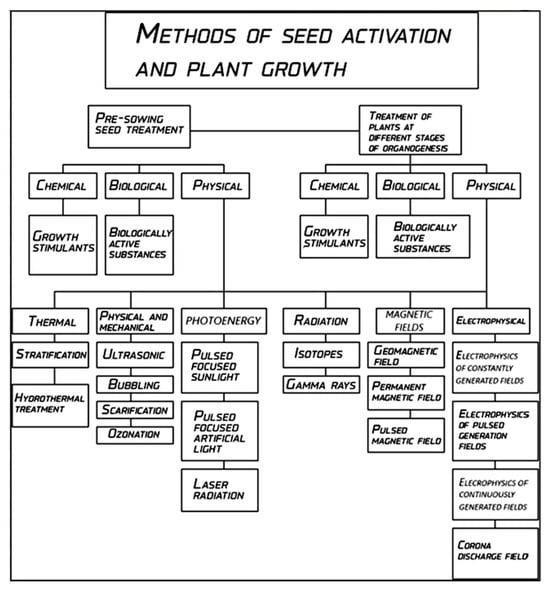
Figure 1.
Methods of seed activation and plant growth.
In addition, the optimality of the recommended modes comes into question when the same modes are applied to seeds not only with different germination rates (due to various factors, including storage conditions) within the same variety but especially for different varieties of the same crop and even for different crops [10,11,33]; in comparison, general biological considerations and experimental data indicate the need to find specific methods for them [13,37]. Thus, without discarding existing experience in the field of laser pre-sowing irradiation methods for vegetable seeds, critically comprehending it and continuing research are necessary, primarily in the direction of finding optimal methods for different crops, varieties, and initial indicators of seed germination.
The aim of this study was to improve the sowing qualities of sunflower seeds based on the use of laser optical radiation.
This study involves the use of theoretical and experimental research methods. Theoretical studies are based on experimental planning methods and statistical data processing methods. When building and studying the model of the influence of radiant energy on the mechanisms of regulation and stimulation of seed germination, methods of operational calculation and methods of solving differential equations were used.
3. Materials and Methods
Based on previous theoretical and experimental studies, the following main results were obtained: due to the dependence of germination and, in this case, the germination of sunflower seeds on the technical parameters of pre-sowing pulse laser irradiation, it is possible to propose new parameters for such technology for vegetable seeds that can effectively shorten the irradiation time and increase productivity and stimulation effects.
In this paper, we propose a method for setting the process parameters for the pre-sowing pulsed laser irradiation of vegetable seeds based on the initial sowing quality, which made it possible to develop suitable technical means for the pre-sowing pulsed laser irradiation of sunflower seeds.
Considering the various methods of action on oil crop seeds, it is advisable to conduct an analytical comparison of the advantages and disadvantages of individual methods in order to determine the most promising methods for use in agricultural production practices [4].
Therefore, it is advisable to consider the main features of those that can be used for oilseeds and to determine the most effective methods for further use and research. The analysis was mainly performed on physical methods of action [5] since the study of chemical methods is beyond the scope of this work; therefore, only the most promising methods are provided for comparison. The theoretical analysis was carried out according to indicators such as the cost of materials and energy; the complexity of the equipment and the need for highly qualified personnel; the duration of processing; the need for dosage accuracy due to the possible negative effect of overdose; the possibility of seed damage during processing [6]; the presence of a harmful effect on service personnel; the identification of biological mechanisms underlying the effect of this action; and the suitability of the method for its automation and the extent of the studied process. The number of indicators includes, in particular, factors such as the clarity of the mechanism of action, which makes it possible to choose treatment modes consciously and not only empirically since the empirical choice of modes can, in some cases, be random, lack reproducibility, and may be far from optimal [7,8].
Of course, the fact that plant seeds, especially in the process of growth and germination, are a complex system on which the action of a stimulating factor is always complex and complicated must be taken into account. The identification of mechanisms of influence is of great scientific and practical importance [9]. In this regard, the key mechanisms of similarity activation for a number of factors, in particular, when using magnetic fields [10], currents [11], gamma radiation, and others, have not yet been fully determined, which restrains their wider application in particular [12].
From the analysis, it can be seen that the most promising processing methods are those that use electromagnetic fields to stimulate similarities, in particular using laser radiation sources and electromagnetic fields in the microwave range [13,14,31]. In addition, it should be taken into account that for laser radiation, in contrast to, for example, gamma radiation, the form of the “dose–effect (i.e., seed germination)–dose” curve for laser radiation has the form of a saturation curve, which eliminates the danger of overdose, unlike, for example, gamma radiation, for which the curve is bell-shaped, as shown in Figure 2 [32,45].
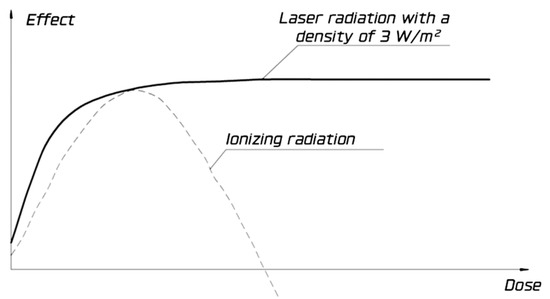
Figure 2.
View of the “dose–effect–dose” curve for different types of actions on seeds.
Taking into account the fact that when using these stimulation methods with fixed devices, these devices will only work for a limited period of the year (before sowing seeds in the soil), it makes more sense to use laser equipment, which has great versatility and can be used for other economic purposes and, ultimately, also makes seed processing cheaper.
The use of laser radiation also has the advantage of ensuring people’s personal safety when creating cheap, specialized, low-productivity devices for homesteads and small farms and reduces costs when using industrially produced low-power laser emitters [33,34,35,36].
In order to assess the dependence of the PYAN on the parameters of pulsed pre-sowing irradiation regimes in the form of a regression equation, it is advisable to conduct a second-order full factorial experiment using the theory of experimental planning in the following stages [40,42]:
- Determination of controlled and uncontrolled factors;
- Determination of the optimal type of experimental plan;
- Construction of an experimental plan with the determination of the boundaries of variation in factors;
- Conducting experimental research;
- Calculation of the coefficients of regression equations;
- Determination of significant coefficients in regression equations;
- Checking the adequacy of the obtained model.
The experiment resulted in the following factors being selected:
—the number of days from exposure to the beginning of the determination of PN, days;
—number of pulses, pcs.;
—energy density, mW/cm2.
The definition of the PYAN was determined based on the percentage of similar seeds in the laboratory [43].
For each factor, coding was performed for given intervals of variation, zero levels.
where is the coded value of the factor (1, −1, 0);
—the natural value of the factor at some level;
—the natural value of the factor at the zero level;
—the variation interval.
Each factor varies on two levels: upper (+) and lower (−) (Table 1).

Table 1.
Factor variation levels.
The second-order model is defined by the following expression:
The regression coefficients of each factor based on the conducted experiments are calculated according to the following formula:
The error of the experiment is calculated according to the following formula:
where is the error of the experiment, which is equal to
—the number of experiments in the center of the plan.
The variances in the regression coefficients are calculated as follows:
The calculated values of Student’s criterion are determined by
Under the condition of the significance of the coefficients,
The adequacy variance for Fisher’s test is calculated as follows:
The estimated value of Fisher’s test is determined by
Under the condition of adequacy,
For a mathematical model of the species, the following equation is used:
Plan matrices have the following form:
Reproducibility variances are determined using the Cochrane criterion
Gp = 0.251 < 0.499 on the basis of which it can be said that the reproducibility of experiments is good.
Polynomial regression coefficients are determined using Student’s criterion.
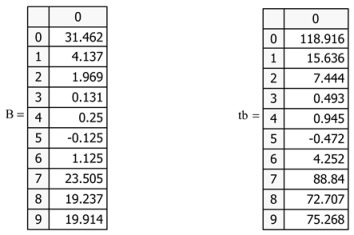
According to Student’s criterion, tp = 1.746. Thus, the coefficient is insignificant and not present in the model.
The equation of the surface of the second order has the following form:
To determine the adequacy of the model, let us compare the critical and calculated values of the Fisher criterion:
1.987 < 2.397
Thus, a nonlinear model was obtained that is adequate to the experimental data, that is, it can be used when constructing the region of the optimum and determining the coordinates of the optimum.
The decoded nonlinear model takes the following form:
Consider the possible two-dimensional values that have the greatest practical significance.
- (1)
- A two-dimensional section of the response surface is characterized as follows: at ;
The response surface represents an ellipsoidal depression, a minimum.
Graphs and level lines are presented in Figure 3.
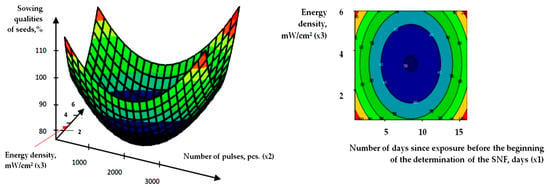
Figure 3.
Surface and level lines of the response function (x1 = 0).
- (2)
- The two-dimensional section of the response surface, which characterizes the response at is calculated as follows:
The response surface represents a circular depression, a minimum.
Graphs and level lines are presented in Figure 4.
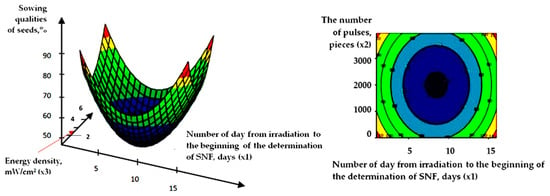
Figure 4.
Surface and level lines of the response function (x2 = 0).
- (3)
- The two-dimensional section of the response surface is characterized as
Graphs and level lines are presented in Figure 5.

Figure 5.
Surface and level lines of the response function (x3 = 0).
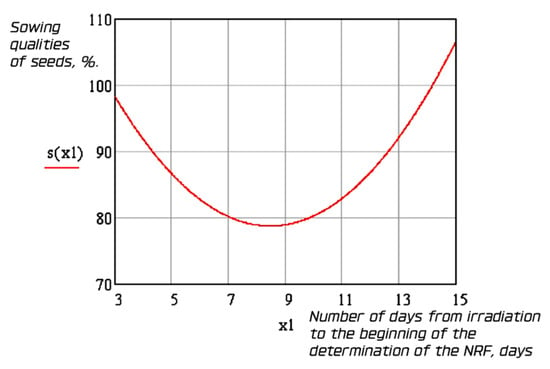
Figure 6.
Graph of dependence x1. Dependence of the PYAN, %, on the number of days from exposure to the beginning of the determination of the PYAN.
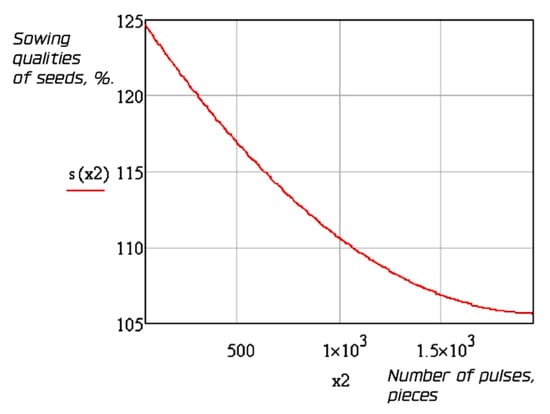
Figure 7.
Graph of dependence x2. Dependence of the PYAN, %, on the number of pulses, thousand pieces.
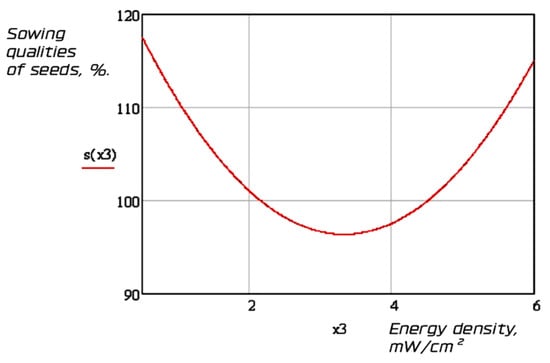
Figure 8.
Graph of dependence x3. Dependence of the PYAN, %, on the energy density, mW/cm2.
Following full factorial experiments, the following optimal values were found: the number of days from exposure to the beginning of the determination of PYAN—8.47 days; the number of pulses—1931 pieces; and the energy density—3.25 mW/cm2. Graphs were obtained for the dependences of the change in the PYAN on the energy density, the number of pulses, and the days from exposure to the beginning of the determination of the PYAN.
4. Development of a Laser Device for Seed Pre-Sowing Treatment
Since the pre-sowing treatment of seeds is most necessary on the farm and the time required for the pre-sowing irradiation of seeds is relatively short, it is recommended to install a device for implementing the established irradiation modes using the simplest possible attachments to an industrially produced fixed laser device [37].
It is well known that various designs for scanning the beam along the plane where the processed seeds are located have been widely employed.
However, all devices using scanning are characterized by the complexity of the design [38], low reliability, and high cost. Therefore, it would be more advantageous to use a “spot–line”-type structure of the fiber optic converter with an obturator-type interruption device with a constant rotational speed, while the relative movement of the converter and the processed material can be carried out in one direction, which greatly simplifies the design and increases its reliability. Based on this decision, we implemented the design of our device for processing seeds, as shown in Figure 9.
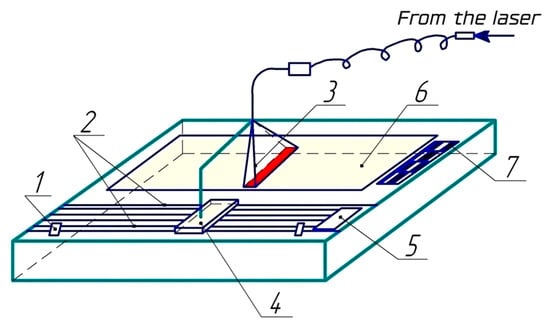
Figure 9.
Laser device: 1—limit switch; 2—guides; 3—fiber optic converter; 4—moving platform; 5—stepper motor; 6—container for seeds; 7—control panel.
The device consists of a fiber optic converter connected to a fiber optic converter that moves along the guidance of a special moving platform, which is set in motion by a stepper motor [39]. The choice of a stepper motor as a drive is due to its properties, as follows:
- The angle of rotation of the rotor is determined by the number of pulses that are applied to the engine;
- The motor provides full torque in stop mode (if the windings are powered);
- Precise positioning and repeatability and high accuracy (3–5% of the step value), and this error does not accumulate gradually;
- The possibility of quick start/stop/reversal;
- High reliability associated with the absence of brushes, where the service life of the stepping motor is in effect determined by the service life of the bearings;
- The explicit dependence of the position on input pulses ensures positioning without feedback;
- The possibility of obtaining very low rotation speeds for the load connected directly to the engine shaft without an intermediate gearbox;
- A fairly large range of speeds can be covered since the speed is proportional to the frequency of the input pulses.
A “spot–line” fiber optic converter-type laboratory device with an interrupting device, such as an obturator, with a constant rotational speed was used. The relative movement of the transducer and the processed material was carried out in one direction, which greatly simplified the design and increased its reliability. The basis of this device is an Atmel-type AT90S2313 microcontroller.
A full factorial experiment was conducted to assess the dependence of the sowing qualities of the seeds (PYAN) on the parameters of pulsed pre-sowing irradiation.
5. Results and Discussion
The purpose of this experimental research was to determine the parameters of a sunflower seed pre-sowing laser irradiation regime [44] that will lead to the maximum stimulating effect on seed quality with minimal energy consumption and the maximum possible productivity. The research was carried out using seeds of oil crops, which occupy the largest area in Ukraine (“Hybrid” varieties). The seeds corresponded to the first reproduction in terms of sowing quality. The established method of artificial aging was used to obtain seeds with a reduced sowing quality, with the aim of finding optimal regimes for pre-sowing irradiation.
The determination of the seed sowing quality was carried out for the initial batch of seeds before irradiation, in addition to after irradiation and subsequent aging of the seeds for 6–7 days, according to recommendations. In all cases, determination of the sowing quality of the seeds (laboratory germination and germination energy) was carried out according to standard methods [46], while the germination of seeds for all crops was carried out using the “on paper” method at a temperature of 20–30 °C (higher when exposed for 8 h; lower when exposed for 16 h). During this process, paper napkins were used, which were checked for compliance with indicators of capillary rise, acidity, and ash content. In both cases, samples were taken in two batches of 30 seeds each, with the determination of laboratory germination and germination dynamics as the average of two indicators of the number of normal seedlings (that is, having a well-developed root system, hypocotyl, and epicotyl).
Germination was carried out by placing moistened paper with seeds on pallets in a thermostatic box, an image of which is shown in Figure 10.

Figure 10.
General view of the thermostatic box.
Figure 11 shows the sunflower seeds of the hybrid first reproduction variety, which were used for the experiment. On the first plate are the seeds that were treated using the laser pulse method, and on the other plate are the seeds that were not treated with a laser. In the first case, the seeds were treated with a laser and photographed after 7 days.
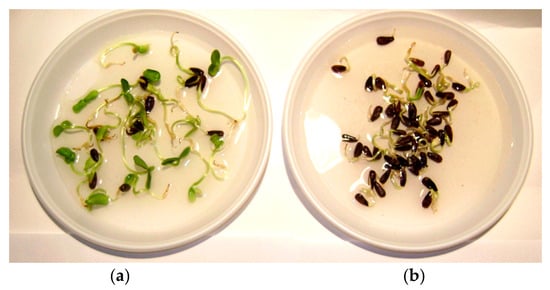
Figure 11.
Test samples of germinated seeds: (a) seeds treated with laser irradiation and (b) seeds that were not subjected to laser irradiation.
Statistical processing of experimental data was carried out according to standard methods. To determine the sum of squares and the dispersion characterizing the error of the experiments, the results of the average value of the center of the plate were used. Thereafter, the value of the dispersion was determined for individual groups of coefficients; lastly, the statistical significance of the coefficients of the regression equation was checked according to the standard method using Student’s t-test, and the confidence interval was calculated according to the following established formula:
where the value of tcrit was determined for the level of significance α = 0.01 and the number of degrees of freedom f2 = 5. Thereafter, after discarding insignificant coefficients, the sum of squares of line-by-line deviant was calculated as follows:
where is the calculated value of the response function, which was calculated for the conditions of the i-th experiment of the plan.
Using Fisher’s F-criterion, the hypothesis of the adequacy of the obtained mathematical model was tested according to a known method, for which the value of Fisher’s criterion was calculated according to the following formula:
where no is the number of degrees of freedom.
where d is the number of significant coefficients in the regression equation.
f1 = N − d − (n0 − 1)
The equation is considered adequate if the following condition is met:
where Fcrit. is determined for the values of f1 and f2 according to the results presented in the tables. They are given for each equation in the corresponding tables for calculating these coefficients).
F < Fcrit.
Variation factors were selected as follows:
—the number of days from irradiation to the beginning of the determination of the sowing quality of the seeds, days; —the number of pulses, pcs.; and —energy density, mW/cm2 (Table 1).
A plan matrix was constructed for the following obtained regression equation based on Equation (10) (Figure 12).
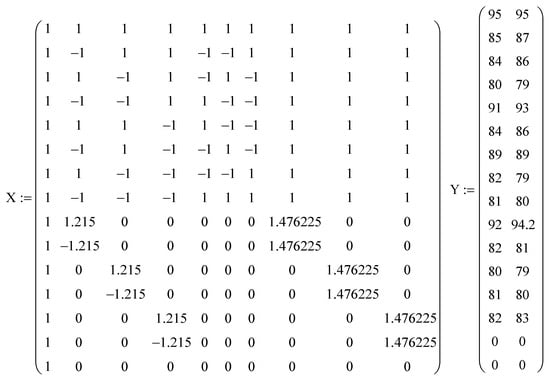
Figure 12.
Plan matrix.
Following its determination according to Student’s criterion and the coefficients of the polynomial regression, the equation of the surface of the second order was obtained as Equation (11).
The adequacy of the model was checked using Fisher’s test.
As a result of conducting a full factorial experiment, the optimal values were found: the number of days from exposure to the beginning of the determination of the PYAN—8.47 days; the number of pulses—1931 pieces; and the energy density—3.25 mW/cm2. We obtained graphs of the dependence of the change in the PYAN on the energy density, the number of pulses, and the days from irradiation to the beginning of the determination of the PYAN.
6. Conclusions
In this paper, we propose a solution to the scientific problem of increasing the efficiency of the pre-sowing pulsed laser irradiation of sunflower seeds. Based on the conducted experimental and theoretical studies, several main conclusions can be drawn.
To increase the yield of sunflowers, it is advisable to employ pre-sowing stimulation of their seeds. The most promising method of such stimulation is pulsed laser irradiation in the red-light range with a wavelength of 630–680 nm, which, through the phytochrome system of the seed, has a stimulating effect on its sowing quality.
Through full factorial experiments, the optimal values for this process were found: the number of days from exposure to the beginning of the determination of the PYAN—8.47 days; the number of pulses—1931 pieces; and the energy density—3.25 mW/cm2. Graphs were constructed that made it possible to determine the dependence of the change in the PYAN on energy density, the number of pulses, and days from exposure to the beginning of PYAN determination.
The application of the specified irradiation regimes makes it possible to increase the PYAN to the level of the first reproduction for seeds corresponding to the second reproduction level according to the initial PYAN and to increase the PYAN to the level of the second class for seeds whose initial PYAN is no more than 15–20% by LV below the level of the second reproduction.
It has been established that for the implementation of the specified irradiation methods, the most advantageous method would be the creation of a device in the form of a laser fiber optic converter with an obturator-type interruption device with a constant speed of rotation.
The design of such a laser device is proposed, and a pulse control system based on the DSHI-200-1 stepper motor with pulse microprocessor control has been developed, which ensures the accuracy of emitter movement with an error of no more than 4% of the step value without its accumulation and allows for the implementation of previously proven methods of pre-sowing seed irradiation.
Experimental tests of the developed device have confirmed its effectiveness for improving PYAN while increasing the yield of the obtained plants by 6–9%, which makes it possible to recommend a reduction in the sowing rates of treated seeds by 4–8%.
The developed system shows great promise in determining optimal methods for processing seeds of various agricultural crops.
Author Contributions
Conceptualization, O.M. and S.P.; methodology, L.E.N.; software, N.Z.; formal analysis, K.A.; database, D.O.; mathematical models, S.P.; resources, D.O.; algorithm and mathematical analysis, K.A.; data curation, N.Z.; writing—original draft preparation, A.A.; writing—review and editing, S.P. and L.E.N.; project administration, O.M. All authors have read and agreed to the published version of the manuscript.
Funding
This research has been funded by the Committee of Science of the Ministry of Science and Higher Education of the Republic of Kazakhstan (Grant No. AP 19677201).
Data Availability Statement
The original contributions presented in the study are included in the article; further inquiries can be directed to the corresponding author.
Conflicts of Interest
The authors declare no conflicts of interest.
References
- Sayler, G.S.; Simpson, M.L.; Cox, C.D. Emerging foundations: Nano-engineering and bio-microelectronics for environmental biotechnology. Curr. Opin. Microbiol. 2004, 7, 267–273. [Google Scholar] [CrossRef] [PubMed]
- The OECD’S Global Relations Programme. Agriculture and Climate Change, Issues for Consideration. Paris, France. 15 May 2009. Available online: https://one.oecd.org/document/CCNM(2009)1/en/pdf (accessed on 3 September 2024).
- Kganyago, M.; Adjorlolo, C.; Mhangar, P.; Tsoeleng, L. Optical remote sensing of crop biophysical and biochemical parameters: An overview of advances in sensor technologies and machine learning algorithms for precision agriculture. Comput. Electron. Agric. 2024, 218, 108730. [Google Scholar] [CrossRef]
- Bellvert, J.; Mata, M.; Vallverdú, X.; Paris, C.; Marsal, J. Optimizing precision irrigation of a vineyard to improve water use efficiency and profitability by using a decision-oriented vine water consumption model. Precis. Agric. 2021, 22, 319–341. [Google Scholar] [CrossRef]
- Arthur, F.K. (Ed.) Encyclopaedia of Seed Production of World Crops; Wiley: Hoboken, NJ, USA, 1998; 414p; ISBN 9780471982029. [Google Scholar]
- Hay, R.K.M.; Heide, O.M. Specific photoperiodic stimulation of dry matter production in high-latitude cultivar of Poa pratensis. Physiol. Plant. 1983, 57, 135–142. [Google Scholar] [CrossRef]
- Dzakovich, M.P.; Gomez, C.; Mitchell, C.A. Tomatoes Grown with Light-emitting Diodes or High-pressure Sodium Supplemental Lights have Similar Fruit-quality Attributes. HortScience 2015, 50, 1498–1502. [Google Scholar] [CrossRef]
- Morgan Pattison, P.; Hansen, M.; Tsao, J.Y. LED lighting efficacy: Status and directions. Comptes Rendus Phys. 2017, 19, 134–145. [Google Scholar] [CrossRef]
- Mamyrbayev, O.; Wojcik, W.; Titova, N.; Pavlov, S.; Oralbekova, D.; Aitkazina, A.; Zhumazhan, N. Development of a thermodynamic model for optimization of processes in crop production. East.-Eur. J. Enterp. Technol. 2023, 6, 25–34. [Google Scholar] [CrossRef]
- Gomez, C.; Morrow, R.C.; Bourget, C.M.; Massa, G.D.; Mitchell, C.A. Comparison of Intracanopy Light-emitting Diode Towers and Overhead High-pressure Sodium Lamps for Supplemental Lighting of Greenhouse-grown Tomatoes. HortTechnology 2013, 23, 93–98. [Google Scholar] [CrossRef]
- Fushchich, V.I.; Nikitin, A.G. Symmetry of Maxwell’s Equations; Naukova Dumka: Kyiv, Ukraine, 1983; pp. 56–60. [Google Scholar]
- Kukharchuk, V.; Wójcik, W.; Pavlov, S.; Katsyv, S.; Holodiuk, V.; Reyda, O.; Kozbakova, A.; Borankulova, G. Features of the angular speed dynamic measurements with the use of an encoder. Inform. Autom. Pomiary W Gospod. I Ochr. Sr. 2022, 12, 20–26. [Google Scholar] [CrossRef]
- Kipenskyi, A.V.; Vasylieva-Linetska, L.Y.; Wojcik, W. Laser and Health. In Physical and Biomedical Electronics; Monograph; City Printing House; National Technical University “Kharkiv Polytechnic Institute”: Kharkiv, Ukraine, 2024; 387p. [Google Scholar]
- Horobets, V.G. Heat Engineering and Use of Heat in Agriculture; CPU Comprint: Kyiv, Ukraine, 2015; 389p. [Google Scholar]
- Ghersa, C.M.; Martinezghersa, M.A.; Benecharnold, R.L. Seed dormancy implications in grain and forage production. J. Prod. Agric. 1997, 10, 111–117. [Google Scholar] [CrossRef]
- Yang, X.; Kuk, J.; Moffat, K. Crystal structure of P. aeruginosa bacteriaphytochrome PaBphP photosensory core domain mutant. Proc. Natl. Acad. Sci. USA 2009, 106, 15639–15644. [Google Scholar] [CrossRef] [PubMed]
- Nishihama, R.; Ishizaki, K.; Hosaka, M.; Matsuda, Y.; Kubota, A.; Kohchi, T. Phytochrome-mediated regulation of cell division and growth during regeneration and sporeling development in the liverwort Marchantia polymorpha. J. Plant Res. 2015, 128, 407–421. [Google Scholar] [CrossRef] [PubMed]
- Buhler, D.D. Effects of tillage and light environment on emergence of 13 annual weeds. Weed Technol. 1997, 11, 496–501. [Google Scholar] [CrossRef]
- Igamberdiev, A.U.; Eprintsev, A.T.; Fedorin, D.N.; Popov, V.N. Phytochrome-mediated regulation of plant respiration and photorespiration. Plant Cell Environ. 2014, 37, 290–299. [Google Scholar] [CrossRef]
- Carmona, R.; Murdoch, A.J. Interactions of temperature and dormancy-relieving compounds on the germination of weed seeds. Seed Sci. Res. 1995, 5, 227–236. [Google Scholar] [CrossRef]
- Khurana, J.P.; Kochhar, A.; Tyagi, A.K. Photosensory perception and signal transduction in higher plants—Molecular genetic analysis. Crit. Rev. Plant Sci. 1998, 17, 465–539. [Google Scholar] [CrossRef]
- Fankhauser, C.; Chory, J. Light control of plant development. Annu. Rev. Cell Dev. Biol. 1997, 13, 203–229. [Google Scholar] [CrossRef]
- Vantuinen, A.; Kerckhoffs, L.H.J.; Nagatani, A.; Kendrick, R.E.; Koornneef, M. Far-red light-insensitive, phytochrome a-deficient mutants of tomato. Mol. Gen. Genet. 1995, 246, 133–141. [Google Scholar] [CrossRef] [PubMed]
- Casal, J.J.; Sanchez, R.A. Phytochromes and seed germination. Seed Sci. Res. 1998, 8, 317–329. [Google Scholar] [CrossRef]
- Casal, J.J.; Sanchez, R.A.; Botto, J.F. Modes of action of phytochromes. J. Exp. Bot. 1998, 49, 127–138. [Google Scholar] [CrossRef]
- Casal, J.J.; Sanchez, R.A.; Yanovsky, M.J. The function of phytochrome A. Plant Cell Environ. 1997, 20, 813–819. [Google Scholar] [CrossRef]
- Furuya, M.; Schafer, E. Photoperception and signalling of induction reactions by different phytochromes. Trends Plant Sci. 1996, 1, 301–307. [Google Scholar] [CrossRef]
- Thomas, T.H.; Hare, P.D.; Vanstaden, J. Phytochrome and cytokinin responses. Plant Growth Regul. 1997, 23, 105–122. [Google Scholar] [CrossRef]
- Yambe, Y.; Takeno, K.; Saito, T. Light and phytochrome involvement in rosa multiflora seed germination. J. Am. Soc. Hortic. Sci. 1995, 120, 953–955. [Google Scholar] [CrossRef]
- Andersson, L.; Milberg, P.; Noronha, A. Germination response of weed seeds to light, light of short duration and darkness after stratification in soil. Swed. J. Agric. Res. 1997, 27, 113–120. [Google Scholar]
- Nikitchin, D.I. Sunflower; Urozhai: Kiyv, Ukraine, 1993; 192p. [Google Scholar]
- Pustovoita, V.S. Sunflower; Pod, O., Ed.; Acad. V.S. Empty; Kolos: Moscow, Russia, 1975; 456p. [Google Scholar]
- Aseev, A.Y. Sunflower Cultivation According to Industrial Technology: Inform; Aseev, A.Y., Humenyuk, A.D., Kislinskyi, A.G., Eds.; Sheet of Central Technical University: Kharkov, Ukraine, 1984; 116p. [Google Scholar]
- Liza, S.A.; Rahman, M.O.; Uddin, M.Z. Reproductive biology of three medicinal plants. Bangladesh J. Plant Taxon. 2010, 17, 69–78. (In English) [Google Scholar] [CrossRef]
- Kushnirenko, A.G. The method of determining the parameters of the electromagnetic field of the technological unit of the installation for pre-sowing treatment of the solution. Mech. Electrif. Agric. 2010, 94, 384–388. [Google Scholar]
- Synetsky, V.G. Pre-Sowing Electromagnetic Treatment of Seeds; Synetskyi, V.G., Bessaratova, V.I., Eds.; Herald of Agrarian Science: Kyiv, Ukraine, 1994; Volume 7, pp. 96–103. [Google Scholar]
- Čėsnienė, I.; Miškelytė, D.; Novickij, V.; Mildažienė, V.; Sirgedaitė-Šėžienė, V. Seed treatment with Electromagnetic Field Induces Different Effects on Emergence, Growth and Profiles of Biochemical Compounds in Seven Half-Sib Families of Silver Birch. Plants 2023, 12, 3048. [Google Scholar] [CrossRef]
- Beyaz, R.; Kahramanogullari, C.T.; Yildiz, C.; Darcin, E.S.; Yildiz, M. The effect of gamma radiation on seed germination and seedling growth of Lathyrus chrysanthus Boiss. under in vitro conditions. J. Environ. Radioact. 2016, 162–163, 129–133. [Google Scholar] [CrossRef]
- Chervinsky, L.S.; Pashkovska, N.I. Investigation of Infrared Radiation Influence on Sowing Quality and Growth Indices of Winter Wheat. J. Visnyk KhNTUSG 2018, 195, 119-112. [Google Scholar]
- Makrushin, N.M. Philosophical and Biological Essence of Seed Quality; Makrushin, N.M., Markushyna, E.M., Malasai, V.M., Eds.; Nauch. tr. KSU: Simferopol, Ukraine, 2000; Volume 66, pp. 115–122. [Google Scholar]
- Lykhatsky, V.I. Vegetable Growing: Workshop; Lykhatskyi, V.I., Burgart, Y.E., Eds.; Higher School: Kyiv, Ukraine, 1994; 366p. [Google Scholar]
- Diordiev, V.T. Comparison of the main methods of pre-sowing seed stimulation of vegetable crops. In Proceedings of the Tavri State Agricultural Technical Academy; Diordiev, V.T., Vasylishyn, R.V., Eds.; TDATA: Melitopol, Ukraine, 2002; pp. 25–29. [Google Scholar]
- Vasylishyn, R.V. Modeling the effect of phytochrome during pre-sowing laser irradiation of seeds to determine the main parameters of irradiation modes. In Problems of Energy Supply and Energy Saving in the Agricultural Sector of Ukraine; Bulletin of the Kharkiv State Technical University of Agriculture; KhDTUSG: Kharkiv, Ukraine, 2002; pp. 65–89. [Google Scholar]
- Diordiev, V.T.; Vasylyshyn, R.V. Use of low-intensity pulsed laser radiation for pre-sowing treatment of vegetable seeds. In Materials of the XVIII International Scientific and Practical Conference; Lazer and Health: Yalta, Ukraine, 2002; 57p; Application of Lasers in Medicine and Biology. [Google Scholar]
- Gotra, Z.Y.; Pavlov, S.V.; Mykytyuk, Z.M.; Zlepko, S.M.; Sushinskyi, O.E.; Vovkotrub, D.V.; Haimzon, I.Y.; Vistak, M.V.; Kholin, V.V. Laser Medical Technologies: Educational Manual; VNTU: Vinnytsia, Ukraine, 2017; 158p. [Google Scholar]
- Vleeshouwers, L.M.; Bouwmeester, H.J.; Karssen, C.M. Redefining seed dormancy: An attempt to integrate physiology and ecology. J. Ecol. 1995, 83, 1031–1037. Available online: https://www.jstor.org/stable/2261184 (accessed on 3 September 2024). (In English). [CrossRef]
Disclaimer/Publisher’s Note: The statements, opinions and data contained in all publications are solely those of the individual author(s) and contributor(s) and not of MDPI and/or the editor(s). MDPI and/or the editor(s) disclaim responsibility for any injury to people or property resulting from any ideas, methods, instructions or products referred to in the content. |
© 2024 by the authors. Licensee MDPI, Basel, Switzerland. This article is an open access article distributed under the terms and conditions of the Creative Commons Attribution (CC BY) license (https://creativecommons.org/licenses/by/4.0/).